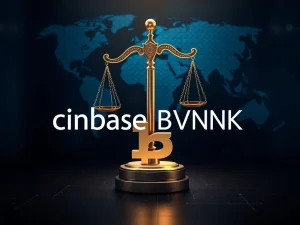Crucial Blockchain Privacy Battle: EU Crypto Regulation’s Impact on Anonymous Transactions by 2027

The digital world constantly navigates a complex tension. Specifically, a crucial battle for blockchain privacy unfolds between innovative blockchain stakeholders and determined state regulators. This ongoing struggle centers on the European Union’s (EU) escalating EU crypto regulation, particularly its sweeping Anti-Money Laundering (AML) framework. The new rules, set to take effect in 2027, will significantly impact the use of privacy-preserving tokens and the availability of crypto anonymity across the bloc. Consequently, understanding these changes is vital for anyone involved in the cryptocurrency space.
The Impending Ban on Crypto Anonymity in the EU
The European Union’s new Anti-Money Laundering Regulation (AMLR) represents a monumental shift. It explicitly prohibits certain practices within the crypto ecosystem. This regulation, scheduled for full implementation by 2027, targets anonymous financial activities. Credit institutions, financial institutions, and crypto asset service providers (CASPs) will face strict new rules. They will no longer maintain anonymous accounts. Furthermore, they will be unable to handle specific privacy-preserving tokens.
This ban directly affects cryptocurrencies designed for enhanced transactional privacy. For instance, Monero (XMR), a prominent privacy coin, falls squarely under this prohibition. Regulators believe these tokens pose a higher risk for illicit activities. They aim to increase transparency across all financial transactions. The objective is clear: to prevent money laundering and terrorist financing. Therefore, the upcoming deadline presents a significant challenge for privacy advocates and developers alike.
Why States Seek Control Over Blockchain Privacy
Maintaining the right to access privacy-preserving coins has become a constant battle. This struggle occurs between blockchain industry stakeholders and various regulators. Anja Blaj, an independent legal consultant and policy expert at the European Crypto Initiative, sheds light on the state’s motivations. “Once you think of how the states want to play out their policies, they want to establish control,” Blaj stated during a recent discussion. She added, “They want to understand who the parties are that transact among themselves.”
Governments seek this understanding for several key reasons. Firstly, they aim to prevent crime and scamming. Secondly, they want to enforce policies created by society. This drive for oversight reflects a broader governmental desire for stability and security. Blaj explained, “[The state] wants to understand that to be able to prevent whatever crime and scamming is happening, and we want to enforce the policies that we create as a society.” Ultimately, this perspective frames blockchain privacy as a potential hurdle to effective state governance and law enforcement.
Navigating the EU Crypto Regulatory Landscape
While the new AML framework crypto is final, experts believe negotiation opportunities remain. Policymaking often involves continuous conversation. This means that “nothing is set in stone, even if the regulation is already out,” Blaj affirmed. She suggests that industry participants still have avenues to engage with regulators. They can discuss how the rules will play out and how enforcement will occur. These discussions could potentially shape the practical application of the regulations.
However, the trend indicates increasing stringency. Regulations concerning privacy-preserving tokens and anonymous accounts are becoming tighter. This trend arises because such privacy features do not align with the interests and planning of states. The EU’s Markets in Crypto-Assets Regulation (MiCA) already laid a foundational layer for comprehensive crypto oversight. The AMLR builds upon this, signaling a firm commitment to regulatory control. Consequently, stakeholders must prepare for a future with less inherent anonymity in EU crypto operations.
The Broader Battle for Digital Privacy: “Chat Control”
The push against blockchain privacy aligns with a separate, broader EU initiative. This proposal, known as “Chat Control,” has regained momentum. It aims to mandate scanning every message, photo, and video sent by users. This requirement would apply even to content protected with end-to-end encryption on platforms like WhatsApp and Telegram. Such a measure represents a significant intrusion into personal digital communications.
Fifteen member states currently support the “Chat Control” bill. However, their collective support does not yet meet the 65% of the EU population threshold required for adoption. Germany, a key player, has shown hesitation. A shift in Germany’s policy could prove decisive for the bill’s future. The convergence of these regulatory efforts – targeting both crypto transactions and private communications – underscores a widespread governmental drive to enhance digital oversight and limit anonymity across various platforms. This highlights the escalating challenges for overall crypto anonymity and digital freedom.
Implications for Privacy-Preserving Tokens and the Future of DeFi
The upcoming ban on privacy-preserving tokens will undoubtedly reshape the EU’s crypto landscape. Projects heavily reliant on anonymity may face significant hurdles. This could force them to adapt or relocate. For users, the ability to conduct truly anonymous transactions within the EU will diminish considerably. This shift raises important questions about individual financial sovereignty and the future direction of decentralized finance (DeFi).
The enhanced AML framework crypto also impacts the broader Web3 ecosystem. Developers must now innovate within stricter regulatory boundaries. They need to explore solutions that balance privacy with compliance. This might involve new forms of verifiable credentials or zero-knowledge proofs that satisfy regulatory demands without completely sacrificing user privacy. Ultimately, the industry must prepare for a future where compliance and transparency become paramount within the EU’s regulated environment.
Preparing for the New Era of EU Crypto Regulation
As 2027 approaches, all participants in the crypto space must proactively prepare for these significant changes. CASPs and financial institutions must update their systems and policies. They need to ensure full compliance with the new AMLR. Furthermore, developers of privacy-preserving tokens should assess their strategies. They must consider the implications for their user base within the EU.
The ongoing dialogue between stakeholders and regulators remains critical. While the framework is largely set, opportunities for clarifying implementation details and addressing unintended consequences still exist. The battle for blockchain privacy is far from over. However, the landscape is undeniably shifting. Stakeholders must adapt to an environment where increased oversight and reduced crypto anonymity become the norm under the rigorous EU crypto regulation.







